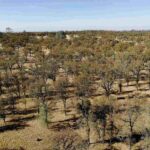
In the burgeoning field of agricultural technology, the integration of digital twin simulations with artificial intelligence is poised to redefine how farming research and operations are conducted. A recent breakthrough pioneered by University of Florida scientists, led by Dana Choi, leverages digital twin technology to revolutionize strawberry farming, enabling year-round research and innovation in an industry traditionally bounded by seasonal constraints.
Strawberry cultivation in Florida typically spans the months from November to April, limiting hands-on experimental activities and delaying advancements during off-seasons. Digital twin technology circumvents this challenge by creating highly realistic virtual replicas of real-world strawberry fields, simulating every aspect from rows and leaves to each individual berry at life size. This virtual laboratory allows scientists to conduct continuous experiments without the need for physical crops or favorable weather conditions, effectively decoupling research timelines from natural growth cycles.
Digital twins, defined as virtual counterparts that mirror physical objects, systems, or processes, have found transformative applications across various industries. In this context, the University of Florida team’s digital twin is not merely a static model but an interactive environment where autonomous robotic systems powered by AI can be tested, trained, and refined. The robotic platforms navigate the digital fields, capturing thousands of synthetic images that mimic the conditions of commercial strawberry farms in Hillsborough County, a region known for its prolific strawberry production.
.adsslot_EXcBZKCAgN{ width:728px !important; height:90px !important; }
@media (max-width:1199px) { .adsslot_EXcBZKCAgN{ width:468px !important; height:60px !important; } }
@media (max-width:767px) { .adsslot_EXcBZKCAgN{ width:320px !important; height:50px !important; } }
ADVERTISEMENT
The cornerstone of this research lies in the use of AI trained exclusively on these synthetic datasets generated within the digital twin environment. Remarkably, the AI system demonstrated an impressive 92% accuracy rate in detecting strawberries in real-world fields without any dependence on physical images. This high level of efficacy underscores the potential for employing simulation-based training to develop robust AI models capable of operating in tangible agricultural settings.
Moreover, the AI’s ability to estimate fruit size with an error margin as low as 1.2 millimeters—a precision sufficient for commercial grading—was achieved solely through simulated data. This signifies a monumental step toward automating quality assessment in agriculture, allowing growers to make data-driven decisions regarding harvest timing and yield prediction without the laborious process of collecting and labeling extensive field data.
Cost and time efficiency are pivotal in technological development, especially in agriculture where seasonal limitations and environmental variability often impede progress. Utilizing digital twins reduces the necessity for labor-intensive fieldwork and extensive image annotation, which traditionally consumes significant resources. By rapidly generating labeled synthetic datasets, scientists can iterate on AI and robotic designs seamlessly within the virtual environment, detecting and correcting issues before deploying prototypes in the actual fields.
The implications extend beyond mere algorithm training. The digital twin platform provides a versatile testbed not only for fruit detection but also for the design and prototyping of autonomous agricultural machinery such as robotic harvesters and smart sprayers. This accelerates the research-to-market pipeline, fostering innovation that could enhance the efficiency, sustainability, and profitability of the $500 million Florida strawberry sector and support the broader $2 billion U.S. strawberry industry.
Furthermore, the virtual environment serves as a practical tool for operator training, enabling users to familiarize themselves with new robotic systems in a risk-free setting. This facet is crucial for minimizing downtime and ensuring smooth integration of automated technologies on farms, where operational errors can result in significant crop loss or damage.
At its core, this project exemplifies how interdisciplinary approaches—combining agricultural engineering, machine learning, and robotics—are catalyzing a paradigm shift in food production. The collaboration seeks to solve real-world challenges by leveraging virtual simulations to overcome the constraints imposed by nature, unlocking unprecedented opportunities for precision agriculture.
Dana Choi and her team emphasize that such developments are vital for sustaining and enhancing crop yields amid evolving environmental conditions and increasing global food demand. Digital twins offer a scalable solution to testing hypotheses, optimizing machinery, and refining AI algorithms without the customary expenses or delays.
In summary, the convergence of digital twin technology and AI-driven robotics heralds a new era of smart farming. By enabling year-round, cost-effective development and immediate iteration cycles, these innovations promise to transform strawberry cultivation and potentially many other crop industries. The capability to predict fruit characteristics accurately and automate labor-intensive tasks paves the way for more resilient, efficient, and technologically advanced agricultural ecosystems.
As this research progresses, it underscores the broader trend of digitization in agriculture, signaling a future where virtual environments complement physical farms to bolster productivity and sustainability on a global scale.
Subject of Research: Strawberry fruit detection and sizing using digital twin-driven AI and robotics in agriculture.
Article Title: From Simulation to Field Validation: A Digital Twin-Driven Sim2real Transfer Approach for Strawberry Fruit Detection and Sizing
News Publication Date: 17-Mar-2025
Web References:
University of Florida – Dana Choi Faculty Page
Florida Strawberry Industry
USDA Fruit Production Value Report
References:
AgriEngineering Journal Article
ScienceDirect: Digital Twins Overview
MDPI Article on Simulated Strawberry Fields
Keywords: Agricultural engineering, Artificial intelligence, Digital twin, Robotics, Precision agriculture, Strawberry detection, Fruit sizing, AI simulation, Autonomous farm machinery.
Tags: AI integration in farmingautonomous robotics in agriculturecost reduction in strawberry cultivationdigital agriculture advancementsdigital twin technology in agricultureinnovative farming solutionsinteractive virtual laboratoriesreal-time farming simulationsseasonal constraints in farmingUniversity of Florida agricultural breakthroughsvirtual simulations for strawberry farmingyear-round agricultural research

